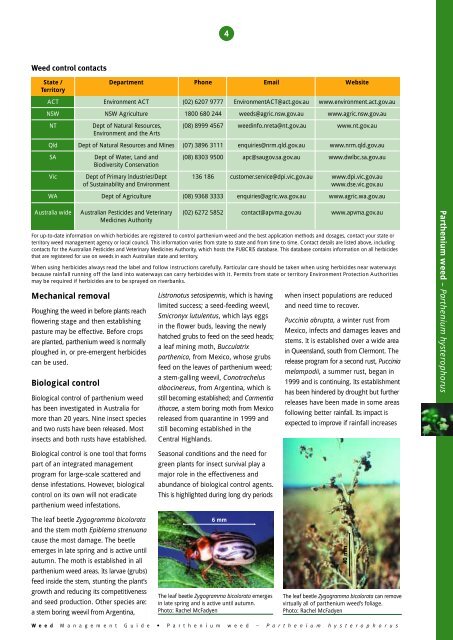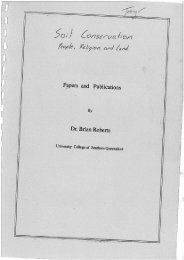Parthenium weed (Parthenium hysterophorus) - South West NRM
Parthenium weed (Parthenium hysterophorus) - South West NRM
Parthenium weed (Parthenium hysterophorus) - South West NRM
Create successful ePaper yourself
Turn your PDF publications into a flip-book with our unique Google optimized e-Paper software.
4<br />
Weed control contacts<br />
State /<br />
Territory<br />
Department<br />
Phone<br />
Email<br />
Website<br />
ACT<br />
Environment ACT<br />
(02) 6207 9777<br />
EnvironmentACT@act.gov.au<br />
www.environment.act.gov.au<br />
NSW<br />
NSW Agriculture<br />
1800 680 244<br />
<strong>weed</strong>s@agric.nsw.gov.au<br />
www.agric.nsw.gov.au<br />
NT<br />
Dept of Natural Resources,<br />
Environment and the Arts<br />
(08) 8999 4567<br />
<strong>weed</strong>info.nreta@nt.gov.au<br />
www.nt.gov.au<br />
Qld<br />
Dept of Natural Resources and Mines<br />
(07) 3896 3111<br />
enquiries@nrm.qld.gov.au<br />
www.nrm.qld.gov.au<br />
SA<br />
Dept of Water, Land and<br />
Biodiversity Conservation<br />
(08) 8303 9500<br />
apc@saugov.sa.gov.au<br />
www.dwlbc.sa.gov.au<br />
Vic<br />
Dept of Primary Industries/Dept<br />
of Sustainability and Environment<br />
136 186<br />
customer.service@dpi.vic.gov.au<br />
www.dpi.vic.gov.au<br />
www.dse.vic.gov.au<br />
WA<br />
Dept of Agriculture<br />
(08) 9368 3333<br />
enquiries@agric.wa.gov.au<br />
www.agric.wa.gov.au<br />
Australia wide<br />
Mechanical removal<br />
Ploughing the <strong>weed</strong> in before plants reach<br />
flowering stage and then establishing<br />
pasture may be effective. Before crops<br />
are planted, parthenium <strong>weed</strong> is normally<br />
ploughed in, or pre-emergent herbicides<br />
can be used.<br />
Biological control<br />
Australian Pesticides and Veterinary<br />
Medicines Authority<br />
Biological control of parthenium <strong>weed</strong><br />
has been investigated in Australia for<br />
more than 20 years. Nine insect species<br />
and two rusts have been released. Most<br />
insects and both rusts have established.<br />
(02) 6272 5852<br />
contact@apvma.gov.au<br />
Listronotus setosipennis, which is having<br />
limited success; a seed-feeding weevil,<br />
Smicronyx lutulentus, which lays eggs<br />
in the flower buds, leaving the newly<br />
hatched grubs to feed on the seed heads;<br />
a leaf mining moth, Bucculatrix<br />
parthenica, from Mexico, whose grubs<br />
feed on the leaves of parthenium <strong>weed</strong>;<br />
a stem-galling weevil, Conotrachelus<br />
albocinereus, from Argentina, which is<br />
still becoming established; and Carmentia<br />
ithacae, a stem boring moth from Mexico<br />
released from quarantine in 1999 and<br />
still becoming established in the<br />
Central Highlands.<br />
www.apvma.gov.au<br />
For up-to-date information on which herbicides are registered to control parthenium <strong>weed</strong> and the best application methods and dosages, contact your state or<br />
territory <strong>weed</strong> management agency or local council. This information varies from state to state and from time to time. Contact details are listed above, including<br />
contacts for the Australian Pesticides and Veterinary Medicines Authority, which hosts the PUBCRIS database. This database contains information on all herbicides<br />
that are registered for use on <strong>weed</strong>s in each Australian state and territory.<br />
When using herbicides always read the label and follow instructions carefully. Particular care should be taken when using herbicides near waterways<br />
because rainfall running off the land into waterways can carry herbicides with it. Permits from state or territory Environment Protection Authorities<br />
may be required if herbicides are to be sprayed on riverbanks.<br />
when insect populations are reduced<br />
and need time to recover.<br />
Puccinia abrupta, a winter rust from<br />
Mexico, infects and damages leaves and<br />
stems. It is established over a wide area<br />
in Queensland, south from Clermont. The<br />
release program for a second rust, Puccinia<br />
melampodii, a summer rust, began in<br />
1999 and is continuing. Its establishment<br />
has been hindered by drought but further<br />
releases have been made in some areas<br />
following better rainfall. Its impact is<br />
expected to improve if rainfall increases<br />
<strong>Parthenium</strong> <strong>weed</strong> – <strong>Parthenium</strong> <strong>hysterophorus</strong><br />
Biological control is one tool that forms<br />
part of an integrated management<br />
program for large-scale scattered and<br />
dense infestations. However, biological<br />
control on its own will not eradicate<br />
parthenium <strong>weed</strong> infestations.<br />
The leaf beetle Zygogramma bicolorata<br />
and the stem moth Epiblema strenuana<br />
cause the most damage. The beetle<br />
emerges in late spring and is active until<br />
autumn. The moth is established in all<br />
parthenium <strong>weed</strong> areas. Its larvae (grubs)<br />
feed inside the stem, stunting the plant’s<br />
growth and reducing its competitiveness<br />
and seed production. Other species are:<br />
a stem boring weevil from Argentina,<br />
Seasonal conditions and the need for<br />
green plants for insect survival play a<br />
major role in the effectiveness and<br />
abundance of biological control agents.<br />
This is highlighted during long dry periods<br />
6 mm<br />
The leaf beetle Zygogramma bicolorata emerges<br />
in late spring and is active until autumn.<br />
Photo: Rachel McFadyen<br />
40 mm<br />
The leaf beetle Zygogramma bicolorata can remove<br />
virtually all of parthenium <strong>weed</strong>’s foliage.<br />
Photo: Rachel McFadyen<br />
W e e d M a n a g e m e n t<br />
G u i d e • P a r t h e n i u m w e e d – P a r t h e n i u m h y s t e r o p h o r u s

















